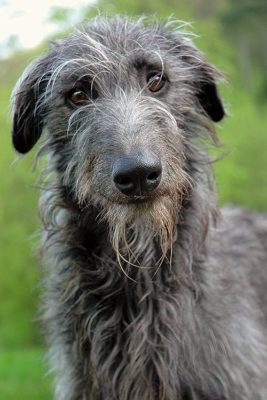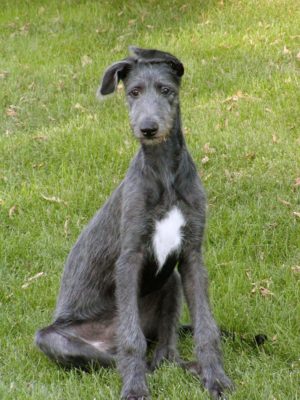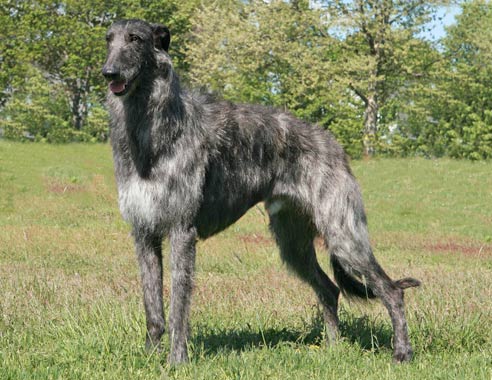Scottish Deerhound
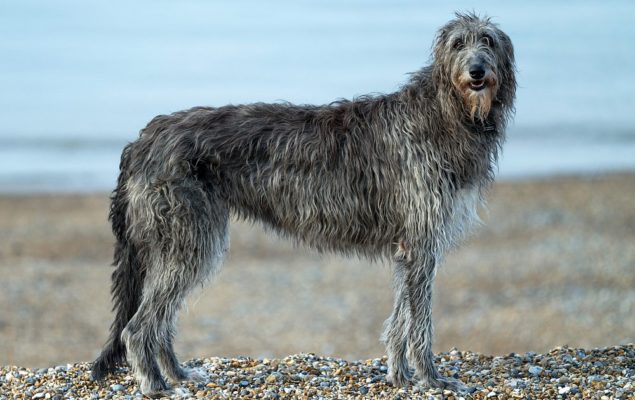
The Scottish Deerhound can best be described as chivalrous. He is gentle but strong, sensitive but brave. Loyal, devoted, quiet, and watchful are all terms that apply to this dog. He is courageous in the face of danger but never aggressive.
Table of Contents
Breed Information
| Another Name | Deerhound |
| Origin | Scotland |
| Height | 71-81 cm |
| Weight | 34-50 kg |
| Fur | Medium |
| Color | All shades of gray and taupe |
| Lifespan | 8-11 years |
| FCI Classification | Sighthounds |
| Group | Dogs for kids, hunting dogs |
| Price | $400-1500 |
Breed Photos
Origin History
The origins of the Scottish Deerhound are lost in the mists of the Highlands. For centuries they have been known as Irish Wolf Dogs, Scottish Greyhounds, Roughhounds, and Highland Deerhounds. It is unknown whether they were originally used for hunting wolves and then converted to hunt big Highlands deer, but we know that they were used as early as the 16th century to hunt and kill deer. Hounds were highly valued for their courage and gentle dignity.
By 1769 the breed was in a terrible state. In the 1820s, Archibald and Duncan MacNeil made efforts to restore the breed to its original glory. The breed also made its way to America. During World War I, the breed’s numbers fell again when many large estates in Scotland and England were destroyed. The Scottish Deerhound once again became a rare breed enjoyed by only a few.
Today the Scottish Deerhound is still a rather unusual breed, appreciated by those who love greyhounds or are interested because of its Scottish origin, but more and more people are learning that it is a versatile breed and an exceptional dog in every respect. Today, the Scottish Deerhound ranks 135th among the 155 breeds and varieties registered by the American Kennel Club.
Appearance
The Scottish Deerhound closely resembles the Greyhound in outline, but it is much larger and sturdier. Its coarse, shaggy coat, created as a result of adaptation to its homeland’s harsh climate, is its second main distinguishing feature. The combination of its long legs, huge chest, and strong backbone reflects a unique combination of strength and speed, and it’s not hard to imagine how a much larger deer could be knocked down.
Its flat, long head has a slight rise to the crown just above the eyes but then smoothly descends to the muzzle without stopping. The muzzle itself is tapered and quite graceful, despite its mass. He has strong jaws and a perfect scissor bite, and his face is covered with relatively long, silky hair that forms a thick mustache. His eyes have black eyelids and are brown, and have a soft appearance.
The front paws of the Deerhound are fairly upright but should not be straight. The lower limbs are broad, with strong bones. The hind limbs have slightly more angulation in the knees, again with heavy bones. Well-developed lumbar musculature. The coat is shaggy, unkempt. Longer fringes on the back of the limbs are found in most dogs. The color of the coat can be different: gray-blue, tiger, yellow or sandy red.
Character
The Scottish Deerhound can best be described as chivalrous. He is gentle but strong, sensitive but brave. Loyal, devoted, quiet, and watchful are all terms that apply to this dog. He is courageous in the face of danger but never aggressive.
Of course, these characteristics don’t just appear. Temperament is influenced by many factors, including heredity, training, and socialization. Puppies with good temperaments are curious and playful, ready to approach people.
Like any dog, Scottish Deerhounds need early socialization – exposure to lots of different people, sights, sounds, and experiences – at a young age. Socialization helps ensure that your Deerhound puppy will grow up to be a versatile dog. Regular invitations to visitors and visits to busy parks, stores where dogs are allowed, and leisurely walk to meet neighbors will also help him hone his social skills.
Care
The Deerhound’s stiff coat is usually easy to care for, but some pets have silkier, longer coats that can get very tangled. However, all he needs is a good brushing with a club brush two or three times a week. Work for the pile with a stainless steel greyhound comb to make sure you don’t miss any tangles, and comb the fur on his muzzle, and you’re all set. This breed requires only a few baths a year.
The rest is basic care. Trim nails as needed, usually once every week or two, and keep ears clean and dry. Check your ears weekly for dirt, redness, or an unpleasant odor that could indicate an infection. If his ears look dirty, wipe them with a cotton swab dipped in a mild, pH-balanced ear cleaner recommended by your veterinarian.
Good oral hygiene is also important. Brush frequently to ensure good overall health and fresh breath. Get your Deerhound used to grooming at an early age, so he learns to accept it willingly and patiently.
Training
The most beautiful Deerhound puppy in the world will only develop into a wonderful adult if given plenty of gentle human interaction, exercise, and proper nutrition. Deerhounds are sensitive and respond best to positive training methods. They will not thrive in a kennel or be abandoned in the house while owners go to work. Although he is quiet and dignified in the house, the Scottish Deerhound may chase any furry animals that run past him. For this reason, breeding walks should be done on a leash or in a fenced area.
Common Diseases
Like other breeds, the Scottish Deerhound can be dangerously susceptible to anesthesia and certain medications. Sudden, fatal stomach illnesses. Owners need to monitor their pet’s health carefully.
While nutrition and exercise are key to creating a healthy, muscular adult puppy, the secret to a healthy and long-lasting Deerhound (besides good genes) is to be happy and well-trained. It is not a breed that tolerates stress well.
And this is not a breed that will only succeed with a daily walk around town. Good health should be maintained through adolescence. If your dog has become tougher on others, keep in mind that the Scottish Deerhound should never be as nice as all other large breeds.
Nutrition
The dog does not require any special feeding. The only necessary condition is that the diet must be balanced. You can opt for super-premium food or accustom your pet to natural food. If you decided to feed your natural dog products, we must remember the following proportions: meat (preferably beef, rich in myoglobin) – 60%; cereals, vegetables, milk, and milk products – 40%. Once a week, we can give him saltwater fish. Also, take care of vitamin supplements. Poultry and fish bones are dangerous for the Deerhound, as they are for other dogs. Change the water regularly; it should be fresh and accessible to your dog at all times.
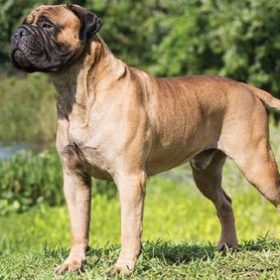 Bullmastiff
Bullmastiff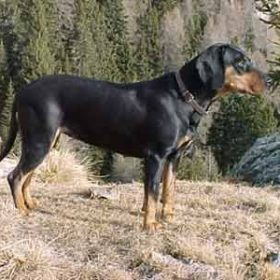 Austrian Black and Tan Hound
Austrian Black and Tan Hound Hygen Hound
Hygen Hound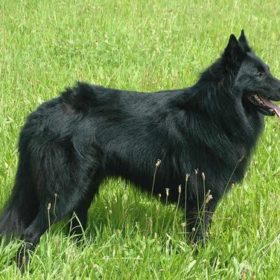 Belgian Shepherd Groenendael
Belgian Shepherd Groenendael Lithuanian Hound
Lithuanian Hound Posavac Hound
Posavac Hound